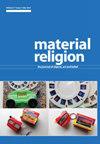The Politics and Poetics of O’odham Categories of Movement: Movement in Discourse and Practice
IF 0.4
3区 哲学
0 RELIGION
引用次数: 2
Abstract
Abstract Through exploring the physicality of movement in general and walking in particular—while also attending to O’odham discourses on these movements—this article arrives at a general, albeit a contested and historically contingent, sketch of an O’odham ideology of walking (and dancing, and perhaps movement in general) as political discourse. More broadly, students of ideology, including religious studies scholars who have historically neglected practice in their fixation on texts, would do well to more carefully attend to movement itself, as well as discourses on movement, in order to more effectively observe, analyze, and theorize ideology at work in both discourse and practice. A focus on both the politics and the poetics of “walking” and what it means “to be a good walker” may also be useful for scholars interested in articulating indigenous (and also non-indigenous) theories of movement that go beyond abstract reifications of “pilgrimage.”奥哈姆运动范畴的政治与诗学:话语与实践中的运动
摘要通过探索一般运动,特别是行走的物理性,同时关注奥对这些运动的论述,本文得出了奥将行走(和舞蹈,也许还有一般运动)作为政治话语的意识形态的总体草图,尽管这是一个有争议的历史偶然性。更广泛地说,意识形态的学生,包括宗教研究学者,他们在历史上对文本的执着中忽视了实践,最好更仔细地关注运动本身以及关于运动的话语,以便在话语和实践中更有效地观察、分析和理论化意识形态。关注“行走”的政治和诗学,以及“成为一个好的行走者”的含义,对于那些有兴趣阐明超越“朝圣”抽象具体化的土著(和非土著)运动理论的学者来说,可能也很有用
本文章由计算机程序翻译,如有差异,请以英文原文为准。
求助全文
约1分钟内获得全文
求助全文

 求助内容:
求助内容: 应助结果提醒方式:
应助结果提醒方式:


